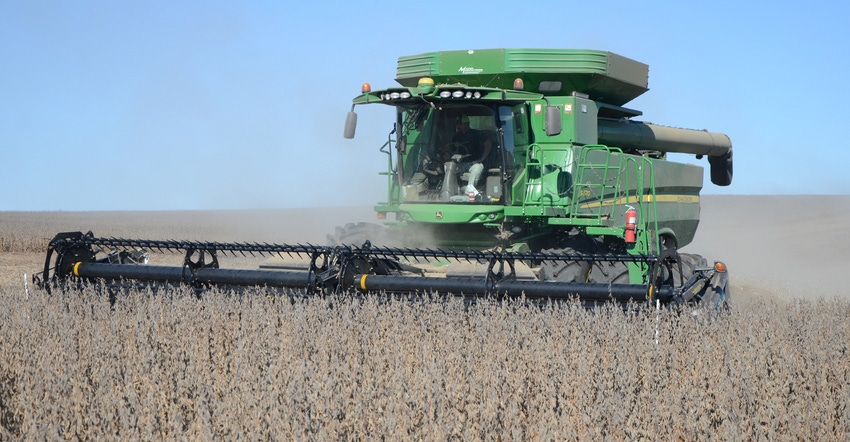
Break the 100-bushel-yield mark for soybeans one year, and it's an accomplishment. Do it consistently for several years, and other growers start paying attention.
This year, Jimmy Frederick, of Rulo, Neb., harvested 148.8-bushel-per-acre rainfed soybeans — after 118-bushel rainfed yields in 2019, 138-bushel rainfed yields in 2018 and 163-bushel irrigated yields in 2017.
What might be even more notable is Frederick reached these high yields with planting populations below 100,000 plants per acre.
"The high-yield field was planted 70,000," Frederick says. "This year, I had plots with populations all the way down to 30,000. I have a higher pod count this year. Across the farm, I was averaging around 450 to 490 pods per plant. I think all the heat and sunlight helped, along with plenty of rain early on."
One of the biggest factors, Frederick says, is the planter adjustments he made this year.
"Planting conditions were great," he says. "I left my corn plates in, the singulators in, I set it the exact same, and it placed them perfectly. The corn plate has a lot less holes — 27 holes instead of 56. I experimented with that to see what would happen, and the outcome was better than I expected. I'm planting low populations, and the meters are still moving pretty quick with less holes, and I had to slow down."
Frederick also is experimenting by putting stress on soybean plants.
"We are using a product, SoyPrime [from Biovante], that changes the hormones in the plant so it thinks it's stressed," he says. "It tightens the nodes, and keeps the plant from getting elongated. On the other hand, normal weather-related stress also plays a role. Up to V3, if it's stressed in any way, it's telling the bean plant we've got some issues, and we need to grow as much as we can. It changes the architecture of that plant."
Numbers game
For Frederick, lower populations are part of a numbers game where the goal is putting on as many lateral branches and pods as possible.
"They've got to have laterals when you lower the population," he says. "You need all the pods you can get. I usually average five to seven laterals, and they all have 70 to 80 pods on them. A lot of counts, I had 137 nodes on one plant. That makes a big difference when you're lowering your population; you really need that plant to express itself."
With these low populations, Chris Masters, CEO at Biovante, notes that it pays off to match the right variety with the growing environment, row spacing and planting population. This year, Frederick went with a variety that was new to him — AgriGold G3520.
"In Jimmy's environment, we're looking for a bean that doesn't get as bushy, because when we drop populations to 60,000 or 50,000, it's excessively bushy," Masters says. "We get all these pods on these laterals, and can't make the laterals hang on long enough to get in the combine. Maturities, genetics, spacing, population all play into what we would choose specific to Jimmy's environment. It's formula that's taken four to five years to tweak and form."
They also focused on getting soybean plants to split at the base, creating what Masters and Frederick refer to as a menorah shape.
"We want to split at the base of the plant, to make it appear and grow as two branches, two main stems, coming from one seed source," Masters says. "With soybeans, we have many farmers who plant 140,000, and we've got spindly little plants. But when we've gone lower, below 100,000, to 70,000 or 60,000, we can take that soybean plant and almost make it a duplicate off the same seed. We're creating three or four lateral branches, and it looks like a menorah."
In addition, because there are fewer plants competing, each plant can produce two or three more nodes on the main stem, as well as a few more pods per lateral branch.
Biologically active soil
Frederick has been applying a cocktail of biological products for about six years, and he credits his yields in part to his biologically active soil helping to mineralize and stabilize nutrients.
This includes Biovante's BioMate, BioCore and BioRed, which are used in combination to help boost soil health, seed viability and plant health.
"We also have to have healthy soil and have the right microbial activity level to have all those functions, like nitrogen fixing capabilities, to reach that yield," Masters says. "He's able to achieve that with little to no synthetic [nitrogen].
"The plant itself is dictating nitrogen uptake through help of continual years of BioRed, along with carbon respiration, and nitrogen-fixing bacteria. It's strictly them doing this on their own as the plant is naturally growing."
"Biological use is a paradigm shift in the industry," he adds. "We're trying to change a narrative that's been ingrained in farming for generations. You have to have somebody forging the way. One record, that's great. Twice, that's starting to get attention. If Jimmy can keep it up, he's raised his averages on production acres by 15 to 20 bushels the last three to four years, and he's profitable."
About the Author(s)
You May Also Like






